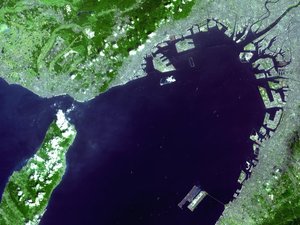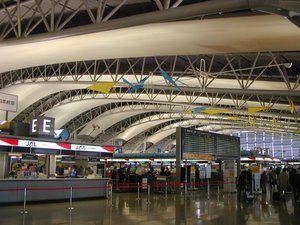Kansai International Airport
|
|

Kansai International Airport (Jp. 関西国際空港 Kansai Kokusai Kūkō) is an international airport located on an artificial island in Osaka Bay, south of Osaka, Japan. It opened on September 4, 1994.
The airport is a hub for Japan Airlines, All Nippon Airways, and Nippon Cargo Airlines. It is the international gateway for the Kansai region, which contains the major cities of Osaka, Kyoto, and Kobe. Most domestic flights fly from the older but more conveniently Osaka International Airport in Itami.
In the Kansai dialect, Kansai Airport is often called Kankū (関空). It has the IATA airport code KIX and the ICAO airport code RJBB.
| Contents |
History
In the 1960s, when the Kansai region was rapidly losing trade to Tokyo, planners proposed a new airport near Osaka and Kobe. Osaka International Airport, located in the densely-populated suburbs of Itami and Toyonaka, was surrounded by buildings: it could not be expanded, and many of its neighbors had filed complaints because of noise pollution problems.
After the protests surrounding New Tokyo International Airport (now Narita International Airport), which was built with confiscated land in a rural part of Chiba prefecture, planners decided to build the airport offshore. Initially, the airport was planned to be built near Kobe, but the city of Kobe refused the plan, so the airport was moved to a more southerly location on Osaka Bay. There, it could be open 24 hours per day, unlike its predecessor in the city. Local fishermen were the only group to protest, but they were silenced by hefty compensation packages.
A man-made island, 4 km long and 1 km wide, was proposed. Engineers faced the risk of earthquakes (very high) and typhoons (with storm surges of up to 3 meters).
Construction started in 1987. The sea wall was finished in 1989 (made of rocks and 48,000 tetrahedral concrete blocks). Three mountains were excavated for 21 million cubic meters of landfill. 10,000 workers and 10 million work hours over 3 years, using 80 ships, were needed to complete the thirty-meter layer of earth over the sea floor and inside the sea wall. In 1990, a three-kilometer bridge was completed to connect the island to the mainland at Rinku-Town, at a cost of $1 billion.
By then, the island had sunk 8 meters (far more than predicted) and the project became the most expensive civil works project in modern history after 20 years of planning, 3 years of construction and several billion dollars of investment.
In 1991, the terminal construction commenced. To compensate for the sinking of the island, adjustable columns were designed to support the terminal building. These could be extended by inserting thick metal plates at their base.
The airport opened in 1994.
In 1995, Kansai Airport was struck by the Kobe earthquake, which was centered just 20 km away and killed 6,433 people on the mainland. The airport, however, emerged unscathed, mostly due to the use of sliding joints in its construction. Even the glass in the windows stayed intact. Later, in 1998, the airport survived a typhoon with wind speeds of up to 200 km/h.
In 2001, the airport was one of ten structures given the "Civil Engineering Monument of the Millennium" award by the American Society of Civil Engineers. [1] (http://www.asce.org/pressroom/news/pr041901_kansai.cfm)
Outlook
Kansai Airport was designed because of two reasons. Osaka International Airport which had reached its capacity, could not expand because of land problems, since the airport was located very close to the city of Osaka. Next, Japan's largest international airport, New Tokyo International Airport's (now Narita International Airport) expansion program was delayed for many years from various problems. Therefore Osaka needed another airport.
The total cost of Kansai Airport so far is $15 billion, which is 40% over budget (mostly due to the sinking problem). The airport is still deeply in debt, losing $560 million in interest every year. Airlines have been kept away by high landing fees (approximately $7500 for a Boeing 747), the second most expensive in the world after Narita's. After deep discounts, the number of flights is increasing.
On February 17, 2005, Chubu Centrair International Airport in the Nagoya region opened, taking over most of Nagoya's (the main airport serving that region) flights, both international and domestic. It is expected that the opening of the airport would increase competition between Japan's international airports. Also, the opening of Kobe Airport in 2006 is expected to further give KIX competition on domestic flights.
The rate of sinking has slowed down markedly in recent years (just 17 cm in 2002). In 2003, believing that the sinking problem was almost over, the airport operators started the construction of a 4,000m second runway, with an estimated project cost of ¥1.56 trillion (approx. US$15 billion). Since the airport is at its limit on "peak" times, a portion of Phase II is scheduled to become operational in 2007. Later on, the airport is planning to construct a new terminal building, apron, and a third runway.
Terminal
Kansai_International_Airport_June_2005.jpg
KIX has a single four-story terminal designed by Renzo Piano. It is the longest building in the world, at a total length of 1.7 km from end to end: a sophisticated people mover system moves passengers from one end of the pier to the other.
The terminal's roof is shaped like an airfoil. This shape is used to promote air circulation through the building: giant air conditioning ducts blow air upwards at one side of the terminal, circulate the air across the curvature of the ceiling, and collect the air through intakes at the other side. Mobiles are suspended in the ticketing hall to take advantage of the flowing air.
The ticketing hall overlooks the international departures concourse, and the two are separated by a glass partition. During Kansai's early days, visitors were known to throw objects over the partition to friends in the corridor below. The partition was eventually modified to halt this practice.
International carriers
International arrivals go to immigration and baggage claim on the first floor. International departures are ticketed on the fourth floor and board from the third floor.
- Air Caledonie Airlines (Noumea)
- Air Canada (Vancouver)
- Air China (Beijing, Dalian, Shanghai Pudong)
- Air France (Paris CDG)
- Air India (Delhi and Mumbai via Hong Kong)
- Air New Zealand (Auckland, Christchurch)
- Air Paradise International (Denpasar)
- Air Tahiti Nui (Papeete)
- Alitalia (Milan)
- All Nippon Airways (Beijing, Dalian, Guam, Hangzhou, Hong Kong, Seoul Incheon, Shanghai Pudong, Shenyang, Qingdao, Xiamen)
- American Airlines (Dallas/Fort Worth) starting November 1, 2005
- Asiana Airlines (Busan, Jeju, Seoul Incheon)
- Australian Airlines (Cairns, Gold Coast)
- Austrian Airlines (Vienna)
- Cathay Pacific (Hong Kong, Taipei)
- China Eastern Airlines (Fuzhou, Guilin, Kunming, Nanjing, Qingdao, Shanghai Pudong, Wuhan, Yantai)
- China Southern Airlines (Dalian, Guangzhou, Shanghai Pudong, Shenyang)
- Egyptair (Cairo, Luxor)
- Emirates (Dubai, UAE)
- EVA Air (Taipei)
- Finnair (Helsinki)
- Garuda Indonesia (Denpasar)
- Hainan Airlines (Haikou)
- JALWays (Guam, Saipan)
- Japan Airlines (Bangkok, Beijing, Brisbane, Busan, Dalian, Denpasar, Guangzhou, Hangzhou, Hanoi, Ho Chi Minh City, Hong Kong, Honolulu, Jakarta, Kuala Lumpur, London Heathrow, Los Angeles, Paris CDG, Qingdao, Seoul Incheon, Shanghai Pudong, Singapore, Sydney)
- Japan Asia Airways (Taipei)
- KLM (Amsterdam)
- Korean Air (Busan, Jeju, Seoul Incheon)
- Lufthansa (Frankfurt)
- Malaysia Airlines (Kota Kinabalu, Kuala Lumpur)
- MIAT Mongolian (Ulan Bator)
- Northwest Airlines (Detroit, Honolulu, Taipei)
- Philippine Airlines (Manila)
- Qatar Airways (Doha)
- Royal Nepal Airlines (Kathmandu via Shanghai Pudong)
- Shanghai Airlines (Shanghai Pudong)
- Singapore Airlines (Bangkok, Singapore)
- Thai Airways International (Bangkok, Los Angeles, Manila, Phuket)
- United Airlines (Chicago O'Hare, Honolulu, San Francisco)
- Uzbekistan Airways (Tashkent)
- Vietnam Airlines (Ho Chi Minh City)
- Vladivostok Air (Vladivostok)
- Xiamen Airlines (Xiamen)
Kixpier.jpg
Kix_jp_bording_lobby.jpg
Domestic carriers
Arrivals, departures, ticketing, and baggage claim are all on the second floor.
- All Nippon Airways (Fukuoka, Goto Fukue, Hakodate, Ishigaki, Kagoshima, Matsuyama, Memanbetsu, Miyako, Miyazaki, Okinawa, Sapporo Chitose, Tokyo Haneda, Wakkanai)
- Japan Airlines (Akita, Fukuoka, Kushiro, Obihiro, Okinawa, Sapporo Chitose, Tokyo Haneda)
- Japan Transocean Air (Ishigaki, Okinawa)
- Skymark Airlines (Tokyo Haneda)
Cargo carriers
(Airlines that operate only cargo flights into the airport)
- Air Hong Kong
- Dragonair
- Federal Express
- Nippon Cargo Airlines
- Scandinavian Airlines System
- United Parcel Service
Ground transportation
- Airport Limousine (Osaka Airport Transport)
- Haruka (West Japan Railway Company) from Kansai Airport Station to Tennoji Station and Kyoto Station
- Rapi:t (Nankai Electric Railway) from Kansai Airport Station to Namba Station
- Hydrofoil service to Awaji Island
External links
- KIX operations website in English (http://www.kansai-airport.or.jp/english/index.htm)
- KIX corporate website (http://www.kiac.co.jp/english/default.htm)
- KIX development website (http://www.kald.co.jp/eindexframe.html)
- History of KIX (http://www.kiac.co.jp/english/history/history.htm)
- Wikitravel: Kansai International Airport (http://wikitravel.org/en/article/Kansai_International_Airport)
- World Airport Guide: Kansai International Airport (http://www.worldairportguide.com/airports/kix/kix.asp)
fr:Aéroport international du Kansai ja:関西国際空港 sv:Kansai internationella flygplats zh:关西国际机场


